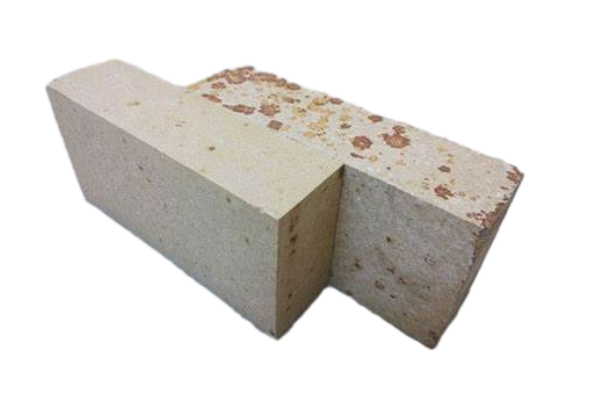
Silica brick for glass kilns is a silica refractory product mainly made of scale quartz used for the masonry of high-temperature parts of glass kilns.
Quarzstein ist der häufigste und wichtigste Ziegeltyp, der in verschiedenen Arten von Glasöfen verwendet wird. Quarzsteine werden hauptsächlich im oberen Bereich des Glasofens verwendet, wie der Dachschwan, Brustwand, Stirnseite, kleiner Ofen, und Wärmespeicherkammer Dachschwan.
Die Rohstoffe für die Herstellung von Siliziumziegeln bestehen hauptsächlich aus kristallinem Quarzit, Zugabe einer kleinen Menge Eisenoxid, und Calciumoxid als Mineralisierungsmittel, um die Ablagerung des Quarzes möglichst vollständig zu fördern und ihn in einem stabilen Temperaturbereich des Brennens zu halten, SiO2-Gehalt von Kieselsteine zu 93% als untere Grenze, hochwertige Produkte für 96% ~ 98%.
Siliziumsteine weisen eine hohe strukturelle Festigkeit bei hohen Temperaturen auf, wie zum Beispiel ein Erweichungspunkt bei hoher Belastung (1640 ~ 1700 ℃) und niedrige Kriechgeschwindigkeit [1550 ℃ – 50h – 0.2MPa – (6 ~ 7) × 10-5]. Und bei der Aufnahme einiger Alkalibestandteile kommt es zusätzlich zu einer sehr leichten Verschmelzung, verringert nicht die strukturelle Festigkeit des Ofendachs.
Das Brennen von Quarzsteinen ist das zentrale Glied im gesamten Produktionsprozess von Quarzsteinen, Dabei muss angestrebt werden, den Abschluss des Phasenumwandlungsprozesses zu maximieren, um eine ideale Mikrostruktur zu bilden und eine bessere Leistung zu erzielen.
Entsprechend den Eigenschaften der Quarzphasenumwandlung, Die folgenden Schritte sollten beim Brennen kontrolliert werden:
(1) 500 ~ 700 Die ℃-Stufe ist β-Quarz, der in den α-Quarz-Bereich umgewandelt wird, mit Volumenausdehnung von 0.82%. Calcium hydroxide decomposes and reacts with the surface of quartz particles in the solid phase to produce CS.
(2) 800 ~ 1000 ℃ range, under the action of the mineralizing agent, can generate a small amount of liquid phase, according to the electronic expansion meter measurement results, this stage has a slight contraction, this stage of firing is still relatively safe.
(3) 1250 ℃ above the temperature range, is the generation of the sub-stable quartz quartz stage, the quartz will have about 15% of the volume of the expansion, and the rate of heating to slow down as much as possible. But the amount of liquid phase generation will gradually increase and will be slightly balanced by the huge volume effect.
(4) 1350 ~ 1450 ℃ is a large number of scale quartz precipitation stage, from α-quartz into scale quartz will have 16.0% volume expansion, but the quartz can not be directly converted into scale quartz. But by the sub-stable quartz into scale quartz, the volume effect of this phase transition is not large.
Jedoch, it is important to control the rate of temperature increase at this stage because: The phase transition from quartz to stabilized quartz still occurs at this stage. This is because (i) the transformation of quartz to sub-stable quartz still occurs at this stage, Und (ii) sufficient time should be given to ensure that the precipitation of the squadron is as complete as possible. daher, the firing and holding time of the stage above 1350°C is very important for the perfection of microstructure formation and obtaining the best high-temperature volume stability.
Silica brick for glass kilns is a silica refractory product mainly made of scale quartz used for the masonry of high-temperature parts of glass kilns. The higher the SiO₂ content in the silica raw material, the higher the refractoriness of the product. Widely used in glass kilns and kiln roofs, pool walls, und andere Teile.
①High-temperature volume stability, will not cause changes in the furnace body due to temperature fluctuations.
② No pollution to the glass liquid.
③ Chemical erosion resistance.
④ Small bulk density.
Silica brick belongs to acid refractory materials, with strong resistance to acidic slag or acidic melt erosion. Jedoch, Es weist eine geringe Beständigkeit gegen alkalische Erosion auf und wird durch die Einwirkung von Oxiden wie Al2O3 leicht zerstört, K2O und Na2O. Es weist eine gute Beständigkeit gegenüber Oxiden wie CaO auf, FeO, Fe2O3, etc.
Siliziumbausteine in weiteren Varianten, entsprechend der Verwendung von Koksöfen mit Siliziumsteinen, Heißluftöfen mit Siliziumsteinen, Elektroöfen mit Siliziumsteinen, Glasöfen mit Silikonsteinen, und so weiter. Die Komplexität des Ziegeltyps wird in Standardziegel unterteilt, Schamottstein allgemeiner Art, Formziegel, und Spezialziegel, etc.
Seit Oktober, Die Preise für Aluminiumoxid sind weiter gestiegen, and China's largest bauxite importer - a…
Erste, Ziegel mit hohem Tonerdegehalt: The Leader In High Temperature Refractories As a leader in high-temperature…
The application of refractory bricks in the kiln immediately endangers the operation rate of the…
Analysis Of The Causes Of Common Quality Problems In Tunnel Kiln Construction And Measures To…
Corundum quality refractory castables are made from corundum to the new jade refractory insulation material…
Analyse feuerfester Aluminium-Silizium-Rohstoffe Prof. Li Yong of the University of Science and…